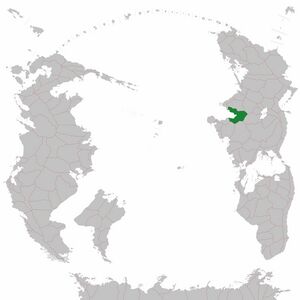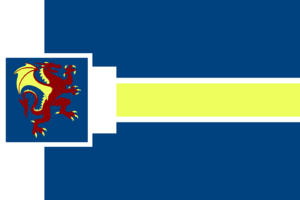Vrigny (Pacifica): Difference between revisions
m (population density) |
|||
| Line 5: | Line 5: | ||
Austral|religion=De jure 100% non-religious|demonym=Vrignyan|government_type=Democratic unitary presidential republic|leader_title1=President|leader_name1=Anneliese Bow|legislature=Parliament|date_event1=~3400 BCE|date_event2=1801-1812|date_event3=1903-1908|date_event4=1921-1932|date_event5=1932-1953|event1=First Zarnarchy|event2=Vrignyan Revolution|event3=Vrignyan Civil War|event4=First Stratocracy|event5=Third Republic|date_event6=1953-2014|event6=Second Stratocracy|event7=Fourth Vrignyan Republic|date_event7=2014-Current|date_start=~4000 BCE|area_km2=181276|population_census=51,237,971|population_census_year=2022|GDP_nominal=$1.601 trillion|GDP_nominal_per_capita=$31,245|GDP_nominal_year=2022|GDP_PPP=$2.386 trillion|GDP_PPP_per_capita=$46,562|GDP_PPP_year=2022|currency=Cernic|currency_code=CRN|Gini=29.3|Gini_year=2022|Gini_change=decrease|time_zone=UTC+2|date_format=dd/mm/yyyy [[wikipedia:common_era|CE]]|drives_on=right|HDI_year=2023|HDI=0.912|HDI_change=increase|cctld=.vy|leader_title2=Vicepresident|leader_name2=Leonard Hustigs}} | Austral|religion=De jure 100% non-religious|demonym=Vrignyan|government_type=Democratic unitary presidential republic|leader_title1=President|leader_name1=Anneliese Bow|legislature=Parliament|date_event1=~3400 BCE|date_event2=1801-1812|date_event3=1903-1908|date_event4=1921-1932|date_event5=1932-1953|event1=First Zarnarchy|event2=Vrignyan Revolution|event3=Vrignyan Civil War|event4=First Stratocracy|event5=Third Republic|date_event6=1953-2014|event6=Second Stratocracy|event7=Fourth Vrignyan Republic|date_event7=2014-Current|date_start=~4000 BCE|area_km2=181276|population_census=51,237,971|population_census_year=2022|GDP_nominal=$1.601 trillion|GDP_nominal_per_capita=$31,245|GDP_nominal_year=2022|GDP_PPP=$2.386 trillion|GDP_PPP_per_capita=$46,562|GDP_PPP_year=2022|currency=Cernic|currency_code=CRN|Gini=29.3|Gini_year=2022|Gini_change=decrease|time_zone=UTC+2|date_format=dd/mm/yyyy [[wikipedia:common_era|CE]]|drives_on=right|HDI_year=2023|HDI=0.912|HDI_change=increase|cctld=.vy|leader_title2=Vicepresident|leader_name2=Leonard Hustigs|population_density_km2=283|population_density_sq_mi=732}} | ||
'''Vrigny''', oficially the '''Fourth Republic of Vrigny''' (Vrignyan: ''Verten Rexpublik Vrigny'') is a medium-sized independent country located in western-central [[Bailtem (Pacifica)|Bailtem]]. It is bordered by [[Izaakia (Pacifica)|Brodlancia]] on the southwest, the South Pacific Ocean on the west, Detroxia as well as [[Sallodesia (Pacifica)|Sallodesia]] on the south and Numano on the east. The country is characterized by its tropical weather on the north, and its oceanic climate on the south. Due to this, most of the country's population, urban areas and farms are located on the south, as well as the east. However, due to a history of deforestation and relentless urban expansion, many of the tropical rainforests of the north have been long gone for ages, being replaced by cities, farms and expansive open-pit mines. | '''Vrigny''', oficially the '''Fourth Republic of Vrigny''' (Vrignyan: ''Verten Rexpublik Vrigny'') is a medium-sized independent country located in western-central [[Bailtem (Pacifica)|Bailtem]]. It is bordered by [[Izaakia (Pacifica)|Brodlancia]] on the southwest, the South Pacific Ocean on the west, Detroxia as well as [[Sallodesia (Pacifica)|Sallodesia]] on the south and Numano on the east. The country is characterized by its tropical weather on the north, and its oceanic climate on the south. Due to this, most of the country's population, urban areas and farms are located on the south, as well as the east. However, due to a history of deforestation and relentless urban expansion, many of the tropical rainforests of the north have been long gone for ages, being replaced by cities, farms and expansive open-pit mines. | ||
Revision as of 22:17, 23 March 2024
Fourth Republic of Vrigny Verten Rexpublik Vrigny | |
|---|---|
|
Flag | |
Motto: Bar ev dett, Rexpublik! Rise and fall, Republic! | |
 | |
| Capital and largest city | Adleimen |
| Official languages | Vrignyan
|
| Religion | De jure 100% non-religious |
| Demonym(s) | Vrignyan |
| Government | Democratic unitary presidential republic |
• President | Anneliese Bow |
• Vicepresident | Leonard Hustigs |
| Legislature | Parliament |
| History | |
• Established | ~4000 BCE |
• First Zarnarchy | ~3400 BCE |
• Vrignyan Revolution | 1801-1812 |
• Vrignyan Civil War | 1903-1908 |
• First Stratocracy | 1921-1932 |
• Third Republic | 1932-1953 |
• Second Stratocracy | 1953-2014 |
• Fourth Vrignyan Republic | 2014-Current |
| Area | |
• Total | 181,276 km2 (69,991 sq mi) |
| Population | |
• 2022 census | 51,237,971 |
• Density | 283/km2 (733.0/sq mi) |
| GDP (PPP) | 2022 estimate |
• Total | $2.386 trillion |
• Per capita | $46,562 |
| GDP (nominal) | 2022 estimate |
• Total | $1.601 trillion |
• Per capita | $31,245 |
| Gini (2022) | low |
| HDI (2023) | very high |
| Currency | Cernic (CRN) |
| Time zone | UTC+2 |
| Date format | dd/mm/yyyy CE |
| Driving side | right |
| Internet TLD | .vy |
Vrigny, oficially the Fourth Republic of Vrigny (Vrignyan: Verten Rexpublik Vrigny) is a medium-sized independent country located in western-central Bailtem. It is bordered by Brodlancia on the southwest, the South Pacific Ocean on the west, Detroxia as well as Sallodesia on the south and Numano on the east. The country is characterized by its tropical weather on the north, and its oceanic climate on the south. Due to this, most of the country's population, urban areas and farms are located on the south, as well as the east. However, due to a history of deforestation and relentless urban expansion, many of the tropical rainforests of the north have been long gone for ages, being replaced by cities, farms and expansive open-pit mines.
Vrigny is a unitary state, without any provinces. With a total area of 181,276 km2 (69,991 sq mi) and a population of 51,237,971, the country has an average population density of 282.65 people/km2 (732 people/sq mi). However, the majority of the population (>80%) lives in the three largest cities of Adleimen, Lifov and Vraks, which have a population of: 32,256,478; 7,215,036 and 3,456,202 respectively. Adleimen, as one of the largest cities in the whole of Pacifica, is the capital of Vrigny. With an area of around 7,200 km2 (sq mi), it is the result of the merging of the former cities of Adlan and Heimen, as a result of an extreme urbanization project led by the previous Dictatorship. This project was frowned upon by many, not because of the large amounts of rainforest cleared for the construction of the cities, but due to the forced resettlement of many rural Vrignyans, accustomed to a peaceful life in their small town, into a more industrialized city full of skyscrapers.
Since the birth of The Fourth Republic in 2014, due to the Constitution written by Samuel Romer and Victor Teryz, the country has been a democratic presidential and constitutional republic, however, until the elaboration of the current, "truly democratic" Constitution, elaborated by the SPV and LPV, Vrigny's democracy was a barely-functional two-party system, which required coalitions to be registered as political parties, and it led to several disagreements of the political sub-groups inside them. With the collapse of the Center Coalition, and later on the Worker's Union, now the independent SPV and LPV transformed Vrigny's democracy into a multiple-party system under proportional representation, and gave the country's only chamber, the Parliament, a total of 425 seats. Vrigny is currently ruled by President Anneliese Bow, from the Green Party of Vrigny (GPV) following its overwhelming victory in the March 24' Snap Elections.
Despite Vrigny's prolonged Dictatorship and isolationism, it mantains a relatively high human development index (HDI) and a decent economy for the size of its population. Vrigny has had an universal public healthcare system since the late Third Republic, and the Dictatorship expanded the public education system as well. The last 10 years of the Fourth Republic have seen a noticeable economic growth and further development of the public sector and services, however, it seems that the nation still remains relatively isolated and has much more potential. The country is a large producer of steel and other refined metals, automobiles, uranium, pharmaceuticals and electronic equipment.
With the country's recent incorporation into the World Forum, its newly established relations with countries all over Pacifica will bring the country's situation into a new era, in which Vrigny will participate with fellow democratic countries and uphold democracy and the Vrignyan view of liberalism all over the world, instead of continuing with its previous prolonged armed neutrality.
Etymology
Vrigny's current name arose after the rise of the Zarkanxiz faith and posterior establishment of the Zarnarchy, around 3400 BCE. It is a shortening of the phrase: Vag raks ig nyn, which is directly translated to: "Long teeth in (this) land". The reason for this phrase is that the Zarkanxiz religion had human sacrifices for the harvesting of blood and the search of an eternal life as its core tenets, leading those which were conquered by the Zarnarchy to name the area controlled by it to describe it by that phrase, and eventually naming it Vrigny as an alternative to Zarkanxiz.
History
Prehistory
Ancient City-States Era
The Rise of Zarkanxiz
The Zarnarchy
Ancient Zarnarchy
Medieval Zarnarchy
(Insert Wars with Brodlancia and Montacia?)
Modern Zarnarchy
The Final Downfall
The Vrignyan Revolution
The First Republic
The Vrignyan Civil War
The Establishment of the SPV
The Second Republic
The First Stratocracy
Ferdinand Lawfen's Coup d'Etat
The MSO plot against Ferdinand Lawfen
The June Revolution
The Third Republic
Dominance of the SPV
The Second Stratocracy
The Generals Revolt
Ferdinand Lawfen's Death
The Fourth Republic
The Writing of the First Constitution
Geography
Climate
The North/South Discrepancy
Hydrology
The Vengril River
Flora
Fauna
Politics
Government
Political Parties
List of political parties in Vrigny (Pacifica)
